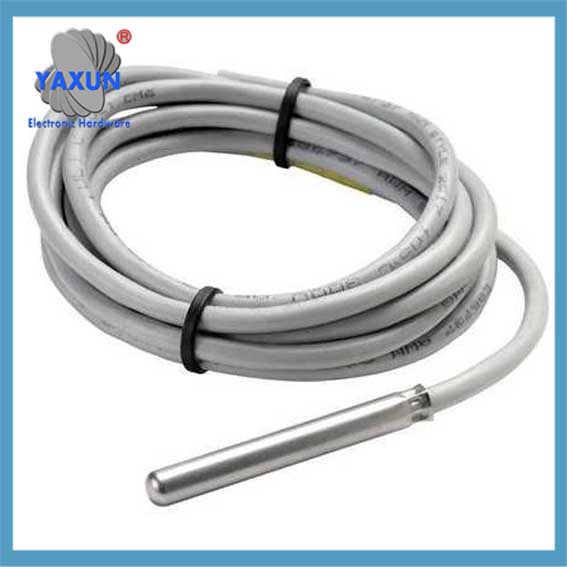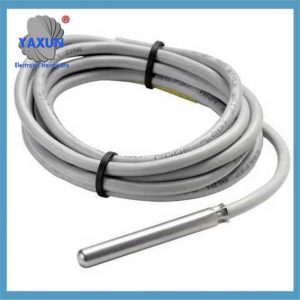产品类别
产品标签
NTC, 正温度系数, PT100, DS18B20 用于温度探头传感器
热电偶探头: 它利用热电效应来测量温度, 并具有测量范围宽、响应速度快的特点.
热电阻探头: 利用金属或半导体材料的电阻随温度变化的特性来测量温度, 并具有测量精度高、稳定性好等特点.
半导体探针: 利用半导体材料的电导率随温度变化的特性来测量温度, 并具有体积小等特点, 重量轻、功耗低.
NTC, 正温度系数, PT100, DS18B20 Temperature probes and temperature sensors play an important role in the field of temperature measurement. The following is a detailed introduction to temperature probe sensors:
温度传感器有很多种类型, 包括:
热电偶
These sensors are made of two dissimilar metals that connect at two points to form a junction. They are reliable, 准确的, and can operate over a wide range of temperatures.
电阻温度探测器 (RTD)
These sensors are based on the change in resistance of a metal as the temperature changes.
热敏电阻
These sensors use the temperature characteristics of semiconductor resistors, which change resistance as the temperature changes. Thermistors are sensitive and have high accuracy relative to their cost.
负温度系数 (NTC) 热敏电阻
These sensors are sensitive and can respond to very small temperature changes. They have a temperature range of -50 °C至 250 ℃.
Resistive temperature detectors
These sensors have positive temperature coefficients (正温度系数) and offer precise temperature measurements. 然而, they have poor sensitivity.
1. Definition and working principle
Temperature probe:
定义: A temperature probe is a device specifically used to measure temperature, and its core component is a temperature-sensitive element.
工作原理: A temperature probe uses sensitive elements (例如热电偶, 热电阻, 半导体, ETC。) to convert temperature changes into electrical signals for subsequent circuit processing or display.
Temperature sensor:
定义: A temperature sensor is a broader concept that includes a temperature probe and a signal processing circuit connected to it.
工作原理: A temperature sensor not only includes a sensitive element, but also has a signal processing circuit that can complete the acquisition, 温度信号的处理和输出, usually in the form of digital or analog signals.
2. Types and characteristics
Temperature probe type:
热电偶探头: 它利用热电效应来测量温度, 并具有测量范围宽、响应速度快的特点.
热电阻探头: 利用金属或半导体材料的电阻随温度变化的特性来测量温度, 并具有测量精度高、稳定性好等特点.
半导体探针: 利用半导体材料的电导率随温度变化的特性来测量温度, 并具有体积小等特点, 重量轻、功耗低.
Temperature sensor type:
Analog temperature sensor: outputs analog signals, which need to be converted into digital signals by analog-to-digital converters for subsequent processing.
Digital temperature sensor: directly outputs digital signals, 具有强大的抗干扰能力, 高精度, and is easy to integrate into the control system.
Intelligent temperature sensor: has self-diagnosis, 自我校准, communication and other functions, 并可以实现远程监视和控制.
3. Selection and application
选择因素:
Application environment: 考虑测得的环境是否具有特殊条件,例如腐蚀性, 高温, 高压, ETC。, 以选择合适的材料和保护水平.
测量范围: 根据要测量的温度范围选择合适的传感器,以确保传感器可以准确测量所需范围内.
准确性要求: According to the accuracy requirements of the application for temperature measurement, select a sensor with corresponding accuracy.
Cost budget: Under the premise of ensuring performance, consider cost factors and choose cost-effective sensors.
Application areas:
工业自动化: used to monitor temperature changes in industrial equipment, machines and production processes to ensure normal operation of equipment and product quality.
Medical industry: used in medical equipment, temperature monitoring instruments and drug storage equipment to monitor patient temperature, 环境温度和药物存储条件.
汽车行业: used in electric vehicle motors, 电容器, 直流转换器, 充电系统, as well as automobile engines, 变速箱, air conditioning systems and exhaust systems to monitor and control the temperature of various liquids and gases.
Agriculture and food processing industry: used in agricultural greenhouses, cold storage, food processing equipment and transport vehicles to monitor and control the temperature of agricultural products and food.
Other fields: such as air conditioning and refrigeration industry, military and aerospace industry, Internet of Things industry, ETC. are also widely used.
四号. 使用与维护
安装: Install the sensor correctly according to the installation instructions to ensure good contact between the sensor and the object to be measured and avoid measurement errors caused by improper installation.
接线: 正确连接传感器的信号线和电源线,以确保信号传输的稳定性和准确性.
校准: 定期校准传感器,以确保其测量精度满足应用要求. The calibration process usually involves placing the sensor in a known temperature environment, comparing the difference between its output value and the standard value, and making necessary adjustments.
维护: 定期清洁并维护传感器以避免灰尘, 污垢, ETC. that affect the measurement performance of the sensor. 同时, pay attention to check whether the cable connection is loose or damaged, and replace damaged parts in time.
总之, temperature probe sensors have a wide range of applications and an important position in the field of temperature measurement. When selecting and using them, it is necessary to make comprehensive considerations based on the specific application scenarios and requirements to ensure the accuracy and reliability of the measurement results. If you have any other questions or need further help, please feel free to let me know.
联系我们
等待您的电子邮件, 我们将在短时间内回复您 12 小时提供您需要的有价值的信息.
 English
English Afrikaans
Afrikaans العربية
العربية বাংলা
বাংলা bosanski jezik
bosanski jezik Български
Български Català
Català 粤语
粤语 中文(简体)
中文(简体) 中文(漢字)
中文(漢字) Hrvatski
Hrvatski Čeština
Čeština Nederlands
Nederlands Eesti keel
Eesti keel Suomi
Suomi Français
Français Deutsch
Deutsch Ελληνικά
Ελληνικά हिन्दी; हिंदी
हिन्दी; हिंदी Magyar
Magyar Bahasa Indonesia
Bahasa Indonesia Italiano
Italiano 日本語
日本語 한국어
한국어 Latviešu valoda
Latviešu valoda Lietuvių kalba
Lietuvių kalba македонски јазик
македонски јазик Bahasa Melayu
Bahasa Melayu Norsk
Norsk پارسی
پارسی Polski
Polski Português
Português Română
Română Русский
Русский Cрпски језик
Cрпски језик Slovenčina
Slovenčina Slovenščina
Slovenščina Español
Español Svenska
Svenska ภาษาไทย
ภาษาไทย Türkçe
Türkçe Українська
Українська اردو
اردو Tiếng Việt
Tiếng Việt












